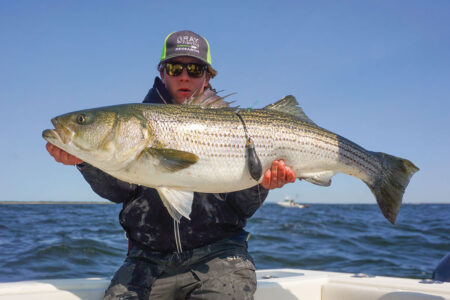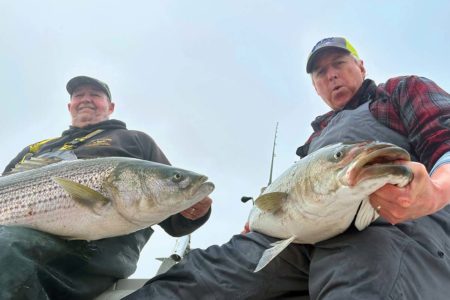
Wrapping up the 2021 Northeast Striped Bass Study with fall deployments & new discoveries.
As last reported in our October (4 Out Of 5: A 2021 Striper Tagging Update) and November editions (Needles & Haystacks: Striper Tags Found In The Surf) we’re honoring the corporate sponsors of the Northeast Striped Bass Study by naming MiniPSAT satellite tracking devices after them, with one big caveat.
It started with a dose of gnarly fall weather that put the kibosh on our plans for a New England deployment on a striper to be named Van Staal; New England edition managing editor Dave Anderson still hopes to put what we believe will be the first ever MiniPSAT device into a surf-caught striped bass sometime in 2022. Next came the tragic loss of one of our spiritual advisors in the Northeast Striped Bass Study, Fred Golofaro, who participated in several of the MiniPSAT deployments off Long Island.
I’m sure Fred would appreciate our future “surf tag” concept, as much as he would the new name added to the mix for deployment number six of the 2021 season honoring him!
Year #1 Revisted
Let’s start by going back to May 21, 2019, when a trophy-hunting team comprised of staff from the nonprofit GrayFishTag Research (GFR), Navionics and The Fisherman hit the lower Hudson River with literally tens of thousands of dollars’ worth of tagging and electronic gear in hopes of successfully deploying a pair of satellite tags in two post-spawn striped bass. Our highly successful and rather surprising initial deployment resulted in our first tagged fish named Liberty and Freedom traveling to great distances.
In Canyon Bound? Liberty’s Message In A Bottle published in the November, 2019 edition of The Fisherman, our 34-inch tagging candidate named Liberty lost her MiniPSAT device after a month and a half at sea, the device itself found on Sagamore Beach, MA near the Cape Cod Canal. According to data stored inside the tag, Liberty wound up in federal waters by Memorial Day weekend in depths to a hundred feet or more of water off the South Shore of Long Island, before pressing offshore in June to parts of Ryan, Nantucket and Clipper canyons, cruising mostly in the 40- to 80-foot depths.
As for Freedom, the December, 2019 edition article titled Tag #2 Is Found! Northeast Striped Bass Study described how this 42-incher would carry the MiniPSAT device for 151 days while traveling equally impressive distances from shore according to Gray FishTag Research’s president, Bill Dobbelaer. “Based upon the three types of data collected this information has shown and we were able to collaboratively state with great certainty that Liberty has traveled over 300 miles (straight line) from New York in an eight-week period spending most of the time in offshore waters following the contour edge of the continental shelf in the Northeast, also known as the canyons,” Dobbelaer said.
That tag’s first upload to the Argos satellite overhead came approximately 8-1/2 miles due east of Sea Bright, NJ starting on October 18, 2019. Just four days later on October 22, 2019, the second Wildlife Computer MiniPAT device was found along the beach near Asbury Park. The same week that Freedom’s tag popped off our fishing reports for the North Jersey region showed a slug of good fish arriving following a slight nor’easter. “When boats got back on the water on Saturday the 19th the stripers were still there and a flotilla of boats found mixed results,” wrote field editor J.B. Kasper at the time, adding “Some of the best fishing was just inside the three-mile line on Saturday.”
Which brings us to 2021, October 14th of this year to be exact; that’s the day that Northeast Striped Bass Study supporter Chuck Many posted to social media, “Log book said it was time for jumbos and boy was it right,” alongside photos showing big stripers well over 40 inches, the biggest just shy of 40 pounds. The next day, the MiniPSAT device which had been in Dave Anderson’s possession arrived at my door, and a new plan was hatched.

Uncle Fred
Photographer Tom Lynch and I met with fellow tag supporter David Glassberg on Many’s boat Tyman at Gateway Marina on the Raritan Bay on the morning of November 2, 2021. Inside a weatherproof gray box was a tagging stick as well as the high tech MiniPSAT device which is designed for tracking larger marine fish, storing hourly temperature, pressure, and light data inside. Pre-programmed to release from the fish after a period of time, the tag is designed to float to the surface, where once in contact with air, the data inside is delivered to the Argos satellite for the duration of battery life (typically two weeks) via antenna at the top of the tag.
Known as one of the region’s top jumbo striper fishermen Many has fished a variety of lures and baits over the years, but his “trophy” tactic for catch and release giants is to deploy live eels on circle hooks beneath planer boards which allows him to set out up to 12 outfits on a slow troll, half that on the drift. Each high-vis planer might have a different depth of deployment for the eel (four or five pulls from the spool versus eight or nine), but it’s very much an amalgam of Chesapeake planer-boarding and kite-fishing, mixed with a bit of Northeast style eeling, though in Chuck’s case, the eels are deployed higher in the water column, often close to the surface.
For years Many kept his method of regularly producing 40- and 50-pound stripers a well-guarded secret, primarily to protect the spawning class stripers known to fall for this technique. Once the slot fish requirement was implemented requiring all “oversized” fish to be released, he’s been more comfortable sharing his tactics. And about a half hour into our light troll on Election Day 2021, Tom Lynch took hold of one of the screaming reels aboard Tyman and with rod buckled over he capably managed a 48-inch striped bass to the net. Our first fish of the day was a beautiful specimen, and it took a matter of minutes to take measurements, deploy the MiniPSAT device along with a secondary GFR green streamer tag, before releasing the fish back into the water.
What’s become a remarkable addition to the local charter fleet in the past 2 years is the incorporation of GFR streamer or spaghetti tags. Information documented on each corresponding card is submitted to GFR to compile; when that fish is reported as caught again, GFR updates their data and makes it available to the public through grayfishtagresearch.org. While many folks felt the slot striper regulation would have a negative impact on the for-hire fleet, local captains participating in the GFR program are now able to offer customers a long-lasting connection to that personal best striper, with the ability to learn more about their named fish well into the future.
For us at the Northeast Striped Bass Study, thinking of how that 2019 tagged fish named Freedom had spent those 151 days of tracking from the lower Hudson in mid-May up until the tag popped free in late October off of Sandy Hook, the fact that another jumbo striper caught and released near that same “pop-off” location could hopefully provide us with another 151-day snapshot into the New Year. Consider Freedom’s travels as a baseline of sorts for our latest big girl.
I quickly jotted down the specifics on the data card (length, estimated weight, LAT/LON, health and vitals of the fish) pausing for a moment before spelling out the fish’s name. While that Election Day fish was most definitely a “her” it was an honor writing down “his” name, Uncle Fred, as the name of our sixth tagged fish in the 2021 Northeast Striped Bass Study.
Our seventh and final MiniPSAT deployment for the year is scheduled for some time in December along the Virginia coast as Chuck hauls his Tyman from North Jersey down coastal Route 13 south to Cape Charles in his quest to break the IGFA catch and release striped bass record, hopefully eclipsing the 60-pound mark this winter.

Hail Mary
Thus far in 2021, we’ve published the findings on four of the five striped bass fitted with satellite tracking devices. AFW was tagged aboard Tyman on May 24 off Sandy Hook and began to upload to the Argos satellite on August 23 near Westerly, RI (41° 20.880 N / 71° 49.140 W) on the day after Tropical Storm Henri made its official landfall at that very location. Regrettably, the data upload didn’t complete, and the tag itself was never found. We did however find the tag from a fish named Navionics which was also tagged on May 24 off Sandy Hook aboard Fin Chasers with Capt. Frank Wagenhoffer. Regrettably that tag came undone less than two weeks after deployment, later being found along the Staten Island shoreline, also with no relevant data.
On June 30, Capt. Al Steiger invited our tagging team to join him aboard his 31-foot Steiger Craft DV Miami off of Montauk, NY where we tagged a pair of fish taping out at 44 and 46 inches. A fish named Seaguar began its upload on July 25 near East Hampton, NY, the tag later found and returned to the GFR team in Florida. The second fish, PENN, would retain its MiniPSAT device until August 24 when it began feeding the Argos Satellite approximately 17 nautical miles south of Fire Island in New York. For details satellite tracking charts see the November edition of The Fisherman. Average depths traveled by each fish were between 30 feet (Seaguar) and 35 feet (PENN).
Our fifth fish of the 2021 season was actually the third one tagged. Hail Mary was tagged and released near Romer Shoal on the Raritan Bay on June 17; it was an emergency deployment of sorts after having learned that Navionics had come ashore at Staten Island prematurely. True to her name, Hail Mary was found along the shoreline at Westhampton Beach on Long Island’s east end by our own study team. As unbelievable as this sounds, GFR’s Roxanne Willmer notified us of the general tag location on September 27; nearly 100 days after the initial tagging on the Raritan, The Fisherman’s Mike Caruso and Matthew Broderick hit Westhampton Beach and actually found the MiniPSAT device in the sand after only about 15 minutes on the hunt.
The tag was shipped from The Fisherman headquarters on Long Island to the Gray Fishtag Research office in Pompano Beach, FL where it was continued to upload until October 15, at which point it was shipped to Wildlife Computers in Redmond, WA for comprehensive analysis.

Shockingly similar our SAT-tagged stripers that came before, data contained inside the MiniPSAT device show Hail Mary tracking E/SE in parallel to the Hudson Canyon to Ambrose Channel Traffic Lane, with a noted cluster of tracks in what appears to be the vicininty of the Bacardi and Texas Tower. She appears to run parallel to Long Island’s south shore well outside of the three-mile-line before setting up for July and August from Nantucket Shoals to an area just inside Georges Bank off of Cape Cod. Like PENN, data shows that Hail Mary averaged depths of about 35 feet over the duration of the deployment, though our study team will be deep-diving in this info in coming months as a sudden and brief deep dive by PENN, Hail Mary and Seaguar simultaneously between July 9 and 13 warrants some further investigation.
Later in August, about the time that AFW’s tag was feeding the Argos satellite up Rhode Island’s Pawcatuck River, Hail Mary seems to have entered Narragansett Bay and into the Providence River, also in the Ocean State. She was inshore and available for Montauk area anglers for a good part of September, before the tag came free and washed ashore at Westhampton Beach later that month.
| STUDY SPONSORS |
| The ongoing and future success of the Northeast Striped Bass Study could not be possible without the generous financial support of valued 2021 national sponsors including Navionics, AFW/HI Seas, Costa Sunglasses, PENN Fishing, Recreational Fishing Alliance through its Fisheries Conservation Trust, Seaguar, Simrad, Southernmost Apparel, and Van Staal.
Our thanks as well to the hundreds of The Fisherman readers who’ve donated, our local fishing club partners including Berkeley Striper Club and the Hudson River Fishermen’s Association, not to mention the incredible support from the Many and Glassberg families. To learn more about Gray FishTag Research and how you can make a charitable donation go to grayfishtagresearch.org. |
Keep in mind, this is not a perfect science. The graphs produced by Gray FishTag Research and Wildlife Computers are essentially averages based on both the transmitted and received data, in addition to the info stored inside each MiniPSAT device that’s physically retrieved. The straight-lines in the mapping are based around the highly concentrated clusters of data that appear in the charts, and represent the mostly likely track of the fish getting from one set of clusters to another. In and around these clusters – based on sea surface temperatures, depth and geolocation collected in the MiniPSAT– the algorithms used in studying the data provide us with the highest probability of tracking.
Webster’s defines science as “knowledge attained through study or practice.” More tags put into more fish means more data; what ultimately ends up happening with that data, we hope, will be up an inquisitive marine scientist to decide. As far as the Northeast Striped Bass Study is concern, there can never be too much data collected on jumbo striped bass.
On to Cape Charles, VA!




